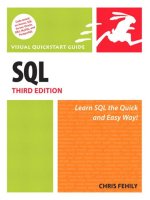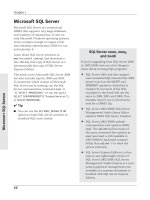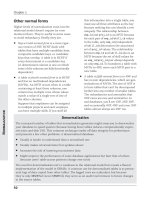SQL VISUAL QUICKSTART GUIDE- P2 ppsx
Bạn đang xem bản rút gọn của tài liệu. Xem và tải ngay bản đầy đủ của tài liệu tại đây (212.26 KB, 10 trang )
This page intentionally left blank
SQL (pronounced es-kyoo-el) is the standard
programming language for creating, updating,
and retrieving information that is stored in
databases. With SQL, you can turn your ordi-
nary questions (“Where do our customers
live?”) into statements that your database sys-
tem can understand (
SELECT DISTINCT city,
state FROM customers;
). You might already
know how to extract this type of information
by using a graphical query or reporting tool,
but perhaps you’ve noticed that this tool
becomes limiting or cumbersome as your
questions grow in complexity—that’s where
SQL comes in.
You also can use SQL to add, change, and
delete data and database objects. All modern
relational database management systems
(DBMSs) support SQL, although support
varies by product (more about that later in
this introduction).
This new edition of SQL: Visual QuickStart
Guide covers the most recent versions of
popular DBMSs, adds a chapter on SQL
tricks, and includes new programming tips,
new sidebars on subtle or advanced topics,
and other odds and ends.
xi
Introduction
i
Introduction
About SQL
SQL is:
◆
A programming language
◆
Easy to learn
◆
Declarative
◆
Interactive or embedded
◆
Standardized
◆
Used to change data and database
objects
◆
Not an acronym
Aprogramming language.SQL is a formal
language in which you write programs to
create, modify, and query databases. Your
database system executes your SQL program,
performs the tasks you’ve specified, and dis-
plays the results (or an error message).
Programming languages differ from natural
(spoken) languages in that programming
languages are designed for a specific pur-
pose, have a small vocabulary, and are inflex-
ible and utterly unambiguous. So if you don’t
get the results you expect, it’s because your
program contains an error—or bug—and
not because the computer misinterpreted
your instructions. (Debugging one’s pro-
grams is a cardinal programming task.)
SQL, like any formal language, is defined by
rules of syntax, which determine the words
and symbols you can use and how they can
be combined, and semantics, which deter-
mine the actual meaning of a syntactically
correct statement. Note that you can write
a legal SQL statement that expresses the
wrong meaning (good syntax, bad seman-
tics). Chapter 3 introduces SQL syntax and
semantics.
xii
Introduction
About SQL
Database vs. DBMS
A database is not the same as the database
software that you’re running; it’s incorrect
to say, “Oracle is a database.” Database
software is called a database management
system (DBMS). A database, which is just
one component of a DBMS, is the data
itself—that is, it’s a container (one or more
files) that stores structured information.
Besides controlling the organization,
integrity, and retrieval of data in databases,
DBMSs handle tasks such as physical
storage, security, backup, replication, and
error recovery.
DBMS also is abbreviated RDBMS, in which
the R stands for relational. An RDBMS
organizes data according to the relational
model (see Chapter 2) rather than, say, a
hierarchical or network model. This book
covers only relational systems, so when I
use DBMS, the initial R is implied.
Easy to learn. Easy compared with other
programming languages, that is. If you’ve never
written a program before, you’ll find the
transition from natural to formal language
frustrating. Still, SQL’s statements read like
sentences to make things easy on humans.
A novice programmer probably would under-
stand the SQL statement
SELECT au_fname,
au_lname FROM authors ORDER BY au_lname;
to
mean “List the authors’ first and last names,
sorted by last name,” whereas the same
person would find the equivalent C or Perl
program impenetrable.
Declarative. If you’ve never programmed,
you can skip this point without loss of conti-
nuity. If you’ve programmed in a language
such as C or PHP, you’ve used a procedural
language, in which you specify the explicit
steps to follow to produce a result. SQL is a
declarative language, in which you describe
what you want and not how to do it; your
database system’s optimizer will determine
the “how.” As such, standard SQL lacks
traditional control-flow constructs such as
if-then-else
,
while
,
for
, and
goto
statements.
To demonstrate this difference, I’ve written
programs that perform an equivalent task in
Microsoft Access Visual Basic (VB; a proce-
dural language) and SQL. Listing i.1 shows a
VB program that extracts author names from
a table that contains author information. You
needn’t understand the entire program, but
note that it uses a
Do Until
loop to define
explicitly how to extract data. Listing i.2
shows how to do the same task with a single
SQL statement (as opposed to about 20 lines
of VB code). With SQL, you specify only what
needs to be accomplished; the DBMS deter-
mines and performs internally the actual step-
by-step operations needed to get the result.
Moreover, Listing i.2 is a trivial SQL query. After
you add common operations such as sorts,
filters, and joins, you might need more than
100 lines of procedural code to accomplish
what a single SQL
SELECT
statement can do.
xiii
Introduction
About SQL
Listing i.1 This Microsoft Access Visual Basic routine
extracts the first and last names from a database table
containing author information and places the results
in an array.
Sub GetAuthorNames()
Dim db As Database
Dim rs As Recordset
Dim i As Integer
Dim au_names() As String
Set db = CurrentDb()
Set rs = db.OpenRecordset("authors")
rs.MoveLast
ReDim au_names(rs.RecordCount - 1, 1)
With rs
.MoveFirst
i = 0
Do Until .EOF
au_names(i, 0) = ![au_fname]
au_names(i, 1) = ![au_lname]
i = i + 1
.MoveNext
Loop
End With
rs.Close
db.Close
End Sub
Listing i.2 This single SQL statement performs the
same query as the Visual Basic routine in Listing i.1.
Access’s internal optimizer determines the best way
to extract the data.
SELECT au_fname, au_lname
FROM authors;
Listing
Listing
Interactive or embedded. In interactive
SQL, you issue SQL commands directly to
your DBMS, which displays the results as
soon as they’re produced. DBMS servers
come with both graphical and command-line
tools that accept typed SQL statements or
text files that contain SQL programs (scripts).
If you’re developing database applications,
you can “embed” SQL statements in pro-
grams written in a host language, which
commonly is a general-purpose language
(C++, Java, or COBOL, for example) or a
scripting language (Perl, PHP, or Python). A
PHP CGI script can use an SQL statement to
query a MySQL database, for example;
MySQL will pass the query result back to a
PHP variable for further analysis or web-
page display. Drawing from the preceding
examples, I’ve embedded an SQL statement
in an Access Visual Basic program in
Listing i.3.
This book covers only interactive SQL. In
general, any SQL statement that can be used
interactively also can be used in a host lan-
guage, though perhaps with slight syntactic
differences, depending on your DBMS, host
language, and operating environment.
Standardized. SQL isn’t “owned” by any
particular firm. It’s an open standard defined
by an international standards working
group, under the joint leadership of the
International Organization for
Standardization (ISO) and the International
Engineering Consortium (IEC). The
American National Standards Institute
(ANSI) participates in the working groups
and has ratified the standard (Figure i.1).
“ISO/IEC SQL” isn’t a commonly used term,
so I’ll stick to the better-known “ANSI SQL”
name throughout this book. This book is
based on the 2003 SQL standard, so you
should consider ANSI SQL, SQL:2003, and
xiv
Introduction
About SQL
Listing i.3 Here, Visual Basic serves as the host
language for embedded SQL.
Sub GetAuthorNames2()
Dim db As Database
Dim rs As Recordset
Set db = CurrentDb()
Set rs = db.OpenRecordset("SELECT au_fname,
➝
au_lname FROM authors;")
' Do something with rs here.
rs.Close
db.Close
End Sub
Figure i.1 This is the cover of ISO/IEC 9075:2003,
which defines the SQL:2003 language officially. You
can buy it in electronic format at
www.ansi.org
or
www.iso.org
if you like. Its intended audience is not
SQL programmers, however, but people who design
DBMS systems, compilers, and optimizers.
Listing
SQL to be synonymous unless I note other-
wise. For more information, see “SQL
Standards and Conformance” in Chapter 3.
All DBMS vendors add proprietary features
to standard SQL to enhance the language.
These extensions usually are additional com-
mands, keywords, functions, operators, data
types, and control-flow constructs such as
if
,
while
, and
goto
statements. Microsoft,
Oracle, and IBM have added so many features
to standard SQL that the resulting languages—
Transact-SQL, PL/SQL, and SQL PL, respec-
tively—can be considered to be separate
languages in their own right, rather than
just supersets of SQL. One vendor’s exten-
sions generally are incompatible with other
vendors’ products. I don’t cover proprietary
SQL extensions, but I do point out when a
vendor’s SQL dialect doesn’t comply with
the standard SQL examples in this book;
see “Using SQL with a specific DBMS” later
in this introduction.
Used to change data and database
objects. SQL statements are divided into
three categories:
◆
Data manipulation language (DML)
statements retrieve, reckon, insert, edit,
and delete data stored in a database.
Chapters 4 through 10 cover the DML
statements
SELECT
,
INSERT
,
UPDATE
, and
DELETE
. Chapter 14 covers
START
(or
BEGIN
),
COMMIT
, and
ROLLBACK
.
◆
Data definition language (DDL) state-
ments create, modify, and destroy database
objects such as tables, indexes, and
views. Chapters 11 through 13 cover the
DDL statements
CREATE
,
ALTER
, and
DROP
.
◆
Data control language (DCL) statements
authorize certain users to view, change,
or delete data and database objects. The
GRANT
statement assigns privileges to
users and roles (a role is a named set of
privileges). The
REVOKE
statement removes
privileges.
GRANT
and
REVOKE
aren’t covered
in this book because they’re the respon-
sibility of database administrators.
All the DBMSs (except Access) covered
in this book support
GRANT
and
REVOKE
,
with variations on the SQL standard.
Not an acronym. It’s a common miscon-
ception that SQL stands for structured query
language; it stands for S–Q–L and nothing
else. Why? Because ANSI says so. The offi-
cial name is Database Language SQL (refer
to Figure i.1). Furthermore, referring to it as
a structured query language is a disservice
to new SQL programmers. It amuses insiders
to point out that “structured query lan-
guage” is the worst possible description,
because SQL:
◆
Isn’t structured (because it can’t be bro-
ken down into blocks or procedures)
◆
Isn’t for only queries (because it has
more than just the
SELECT
statement)
◆
Isn’t a language (because it’s not Turing-
complete, which you’ll study should you
take Theory of Computation)
xv
Introduction
About SQL
About This Book
This book will teach you how to use the
SQL programming language to maintain
and query database information. After some
expository material about DBMSs, the rela-
tional model, and SQL syntax in Chapters 1
through 3, I revert to the task-based, visual
style that you’re familiar with if you’ve read
other Visual QuickStart books.
Although I don’t assume that you’ve had
programming experience, I do expect that
you’re competent with your operating sys-
tem’s filesystem and know how to issue
commands at a command prompt or shell
(called the DOS prompt in older Windows
versions or Terminal in Mac OS X).
This book isn’t an exhaustive guide to SQL;
I’ve limited its scope to the most-used state-
ments. For information about other SQL
statements, refer to your DBMS’s documen-
tation or an SQL reference that covers the
standard more completely.
✔ Tips
■
Peter Gulutzan and Trudy Pelzer’s SQL-99
Complete, Really (CMP Books) explains
the complete SQL-99 standard. It’s less
agonizing to read than the SQL standard
itself, but it doesn’t cover individual
DBMSs.
■
Kevin Kline, Daniel Kline, and Brand Hunt’s
SQL in a Nutshell (O’Reilly) is an extensive
SQL:2003 reference that covers the same
DBMSs as this book (except Access).
It’s appropriate for SQL programmers
who already have learned the basics.
■
Troels Arvin’s “Comparison of Different
SQL Implementations” explains how
different DBMSs implement various SQL
features, complete with links to source
documentation and other SQL books,
articles, and resources. It covers
SQL:2003 and the same DBMSs as this
book (except Access). It’s at
http://
troels.arvin.dk/db/rdbms
.
xvi
Introduction
About This Book
Companion Website
At
www.fehily.com
, you’ll find correc-
tions, updates, all code listings, and the
sample database ready for download (see
“The Sample Database” in Chapter 2).
Click the Contact link to send me ques-
tions, suggestions, corrections, and gripes
related to this book.
Audience
My audience is database-application pro-
grammers and database end-users (not
database designers or administrators), so
this book is appropriate for you if you:
◆
Lack programming experience but are
familiar with computers.
◆
Are learning SQL on your own or from
an instructor.
◆
Are otherwise uninterested in databases
but must process large amounts of struc-
tured information because of the nature
of your work. This group includes statisti-
cians, epidemiologists, web programmers,
meteorologists, engineers, accountants,
investigators, scientists, analysts, sales
reps, financial planners and traders, office
managers, and managers.
◆
Want to move beyond friendly but
underpowered graphical query tools.
◆
Are moving from a desktop to a server
DBMS (see the sidebar in this section).
◆
Already know some SQL and want to
move past simple
SELECT
statements.
◆
Need to create, change, or delete data-
base objects such as tables, indexes,
and views.
◆
Need to embed SQL code in C, Java, Visual
Basic, PHP, Perl, or other host languages.
◆
Are a web programmer and need to dis-
play query results on web pages.
◆
Need a desktop SQL reference book.
◆
Are migrating from Microsoft Excel
to Access because your data lists have
grown too big or complex to manage
in a spreadsheet.
xvii
Introduction
About This Book
SQL Server vs. Desktop DBMSs
An SQL server DBMS acts as the server
part of a client/server network; it stores
databases and responds to SQL requests
made by many clients. A client is an appli-
cation or computer that sends an SQL
request to a server and accepts the serv-
er’s response. The server does the actual
work of executing the SQL against a data-
base; the client merely accepts the answer.
If your network uses a client/server archi-
tecture, the client is the computer on
your desk, and the server is a powerful,
specialized machine in another room,
building, or country. The rules that
describe how client/server requests and
responses are transmitted are part of
DBMS protocols and interfaces such as
ODBC, JDBC, and ADO.NET.
A desktop DBMS is a stand-alone pro-
gram that can store a database and do all
the SQL processing itself or behave as a
client of an SQL server. A desktop DBMS
can’t accept requests from other clients
(that is, it can’t act like an SQL server).
SQL servers include Microsoft SQL Server,
Oracle, DB2, MySQL, and PostgreSQL.
Desktop systems include Microsoft Access
and FileMaker Pro. Note that SQL server
(not capitalized) can refer to any vendor’s
SQL server product, and SQL Server (capi-
talized) is Microsoft’s particular SQL server
product. By convention, I use client and
server to refer to client and server soft-
ware itself or to the machine on which
the software runs, unless the distinction
is important.
This book is not appropriate for you if you
want to learn:
◆
How to design databases (although I
review proper design concepts in
Chapter 2).
◆
Proprietary extensions that DBMS ven-
dors add beyond the basic SQL statements.
◆
Advanced programming or administra-
tion. I don’t cover installation, privileges,
triggers, recursion,* stored procedures,
replication, backup and recovery, cursors,
collations, character sets, translations,
XML, or object-oriented extensions.
Typographic conventions
I use the following typographic conventions:
Italic type introduces new terms or repre-
sents replaceable variables in regular text.
Monospace type
denotes SQL code and
syntax in listings and in regular text. It also
shows executables, filenames, directory
(folder) names, URLs, and command-
prompt text.
Red monospace type
highlights SQL code
fragments and results that are explained in
the accompanying text.
Italic monospace type
denotes a variable in
SQL code that you must replace with a
value. You’d replace
column
with the name of
an actual column, for example.
Syntax conventions
SQL is a free-form language without restric-
tions on line breaks or the number of words
per line, so I use a consistent style in SQL
syntax diagrams and code listings to make
the code easy to read and maintain:
◆
Each SQL statement begins on a
new line.
◆
The indentation level is two spaces.
◆
Each clause of a statement begins on a
new, indented line:
SELECT au_fname, au_lname
FROM authors
ORDER BY au_lname;
◆
SQL is case insensitive, which means
that
myname
,
MyName
, and
MYNAME
are con-
sidered to be identical identifiers. I use
UPPERCASE
for SQL keywords such as
SELECT
,
NULL
, and
CHARACTER
(see “SQL
Syntax” in Chapter 3), and
lowercase
or
lower_case
for user-defined values, such
as table, column, and alias names.
(User-defined identifiers are case sensitive
when quoted and in a few other situations
for some DBMSs, so it’s safest to respect
identifier case in SQL programs.)
◆
Table i.1 shows special symbols that I
use in syntax diagrams.
◆
All quote marks in SQL code are straight
quotes (such as
‘
and
“
), not curly, or
smart, quotes (such as ’ and “). Curly
quotes prevent code from working.
◆
When a column is too narrow to hold a
single line of code or output, I break it
into two or more segments. A gray arrow
➝
indicates a continued line.
xviii
Introduction
About This Book
* To understand recursion, you first must understand
recursion.
Using SQL with a specific DBMS
This icon indicates a vendor-
specific departure from the
SQL:2003 standard. If you see this icon, it
means that a particular vendor’s SQL dialect
doesn’t comply with the standard, and you
must modify the listed SQL program to run
on your DBMS. For example, the standard
SQL operator that joins (concatenates) two
strings is
||
(a double pipe), but Microsoft
products use
+
(a plus sign) and MySQL uses
the
CONCAT()
function instead, so you’ll need
to change all occurrences of
a||b
in the
example SQL listing to
a + b
(if you’re using
Microsoft Access or Microsoft SQL Server)
or to
CONCAT(a,b)
(if you’re using MySQL).
In most cases, the SQL examples will work
as is or with minor syntactic changes.
Occasionally, SQL code won’t work at all
because the DBMS doesn’t support a partic-
ular feature.
This book covers the following DBMSs
(see the next chapter for details):
◆
Microsoft Access
◆
Microsoft SQL Server
◆
Oracle
◆
IBM DB2
◆
MySQL
◆
PostgreSQL
If you’re using a different DBMS (such as
Teradata, Sybase, or Informix), and one of
the SQL examples doesn’t work, read the
documentation to see how your DBMS’s
SQL implementation departs from the SQL
standard.
xix
Introduction
About This Book
Table i.1
Syntax Symbols
Characters Description
|
The vertical-bar or pipe symbol separates
alternative items. You can choose exactly
one of the given items. (Don’t type the ver-
tical bar.)
A|B|C
is read “A or B or C.”
Don’t confuse the pipe symbol with the
double-pipe symbol,
||
, which is SQL’s
string-concatenation operator.
[]
Brackets enclose one or more optional
items. (Don’t type the brackets.)
[A|B|C]
means “type
A
or
B
or
C
or type nothing.”
[D]
means “type
D
or type nothing.”
{}
Braces enclose one or more required
items. (Don’t type the braces.)
{A|B|C}
means “type
A
or
B
or
C
”.
Ellipses mean that the preceding item(s)
can be repeated any number of times.









